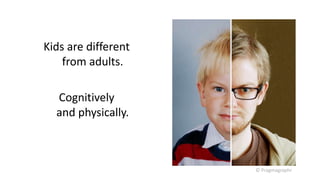10 Game Design Principles for the Next 10 Years
- 1. 10 Game Design Principles for the Next 10 Years Carla Fisher, Ed.D. No Crusts Interactive
- 2. But isn’t claiming to know the future as much a faux pas as comic sans on your business cards?
- 4. Kids are different from adults. Cognitively and physically. © Pragmagraphr
- 5. © epSos.de
- 7. 1. Look for inspiration in inappropriate places everywhere
- 13. 2. Foster dialogic play
- 17. vs
- 20. Hundreds
- 23. 3. Practice dual-premise game design
- 31. 4. Scaffold
- 32. 2
- 33. Zone of Proximal Development • Pair players together based on unequal abilities. – The more capable tugs the other along, encouraging reaching the next level © State Records NSW
- 34. What I can do What I can do with help What I can’t do Zone of Proximal Development Wash hands Pour milk into bowl Put cookies in ovenPour pre-measured ingredients Sift flour Measure ingredients Measure ingredients Eat cookies (and dough) Roll out cookie dough Decorate cookies Read recipe
- 36. Scaffolding • In a classroom, the teacher – grabs the student’s attention – creates and adjusts the task – provides encouragement and motivation – highlights task features that are most relevant to the learning goals and the student’s abilities – adjusts the task to moderate frustration – models and demonstrates the task where needed © nathanrussell
- 37. Typical Educational Game Scaffold • 1st wrong Encourage the player to try again • 2nd wrong Play short hint • 3rd wrong Highlight correct answer
- 41. Motion Math Zoom
- 42. 5. Embrace data.
- 48. The Eyeballing Game The Eyeballing Game
- 49. Perfect Slice
- 50. 6. Provide real-time, contextualized feedback
- 51. Real-Time Feedback • Feedback loop between student & teacher, often with technology • Teacher strategy to review student work repeatedly and adjusting the instruction accordingly • Variations include – Just in Time Instruction – Computer-Assisted Instruction © nSeika
- 52. Parent dashboards and progress reporting
- 56. 7. Use achievements to motivate new ways of playing
- 57. 8. Be different.
- 61. Standing Out • Avoid crowded content areas unless you’re really, truly, completely, 100% different – or have a ton of money – or are Disney • Do your homework to find gaps in the market
- 65. 10. Test early. Test often. Adjust. Repeat.
- 66. 11. Foster discovery and curiosity.
- 70. MyRobotFriend
- 71. Scribblenauts
- 72. Minecraft
- 74. Makey Makey
- 75. Thanks! • carla@NoCrusts.com • @NoCrusts • Kids Got Game blog on Kidscreen.com
Editor's Notes
- http://www.flickr.com/photos/thedalogs/3021721046/sizes/o/in/photostream/
- http://www.flickr.com/photos/jpovey/2664311358/sizes/o/in/photostream/
- http://www.flickr.com/photos/sflovestory/3138073571/
- http://www.flickr.com/photos/enixii/2764222069/
- http://4.bp.blogspot.com/-q0Yv1FmcnMg/UEP4EzOTgPI/AAAAAAAAGUo/R4GyKooRH9Y/s1600/Cards_Against_Humanity-3-e1344299013147.jpg
- But digital games are often designed this way. And this is what causes some of the concerns about games being isolating.
- One of the best examples of kids playing together is this video. (And, on a side note, even with collaboration, scaffolding, and modeled behaviors, expect a little chaos!) Video http://www.youtube.com/watch?v=4j4l0lWfEEcThis is one of my favorite examples of kids playing together and being accidentally successful as well. The game isn’t penalizing them for the chaos in the room. It just keeps chugging along! So it allows the kids to play together instead of punishing them, which happens with many of these dance games – where the song will end if there’s too many incorrect actions.
- http://talkingaboutgames.com/wp-content/uploads/2012/08/left4dead2coldstreamhighway.jpg
- http://4.bp.blogspot.com/-SQiGWUgQQeg/TpxVkK9rP4I/AAAAAAAAACY/Fi6TDYC9U6E/s1600/unhappy-girlfriend-boyfriend-video-game.jpg
- Borderlands 2
- Giving power ups for performance
- http://www.flickr.com/photos/crincon/1045641553/sizes/l/in/photostream/
- Scaffold wrong answers whenever possible, but don’t get so scaffolded that it draws out gameplay endlessly. The model shown is just one way to scaffold for wrong answers. But scaffolding can also be for levels of gameplay, based on factors such as right answers or time on task. [Images to come]
- Don’t hijack the game to provide the learning moment.
- Collect and visualize data, particularly within activities that are familiar to the child. And we can return to the topic of why adults need to be reeducated to.
- [Discuss Census maps of response rate to surveys and how information can be explored.]
- TeachMe Toddler
- http://www.flickr.com/photos/amagill/4223790595/sizes/o/in/photostream/
- Repeated exposures to content over time is preferred
- Asynchronous and/or episodic games
- http://www.flickr.com/photos/basykes/4431284592/sizes/o/in/photostream/
- At it’s core, STEM is about fostering curiosity and discovery. It is about instilling in children the desire to find out on their own, not always to be taught. While discovery is a natural inclination of children, it is not a fundamental goal of today’s traditional science and math pedagogy.Ideally, STEM is about encouraging exploration of the environment, asking questions, and being curious beyond initial comprehension. Doing so fosters the mindsetof STEM rather than the facts of STEM. © DarrelBirkett, mollypop, trec_lit, haemengine
- http://www.flickr.com/photos/aloha75/8111417059/sizes/o/in/photostream/ Sam Howzi“Intrinsic motivation is all-too-frequently extinguished by extrinsic goals and expectations of school.”Margaret Honey and David E. Kanter, Design, Make, Play: Growing the Next Generation of STEM Innovators
- http://www.wpclipart.com/education/supplies/periodic_table_of_the_elements.png.html
- http://www.flickr.com/photos/barockschloss/4644179414/sizes/o/in/photostream/http://www.flickr.com/photos/usfwsmtnprairie/5957832651/sizes/o/in/photostream/http://www.flickr.com/photos/usacehq/7217159406/sizes/o/in/photostream/
- ScribblenautsTrial and errorMultiple paths to success, but rewards most efficient path?Create your own puzzles – systems thinking
- Minecraft – Sandbox gamesExplorationTrial and errorCommunity of explorers/creators – play each other creationsThe game involves players creating and destroying various types of blocks in a three dimensional environment. The player takes an avatar that can destroy or create blocks, forming fantastic structures, creations and artwork across the various multiplayer servers in multiple game modes. http://www.flickr.com/photos/kjarrett/8365208683/sizes/z/in/photostream/











































































